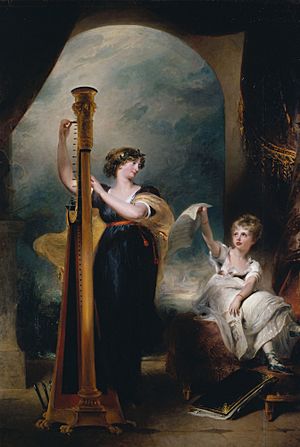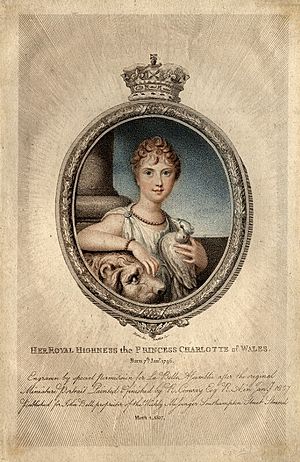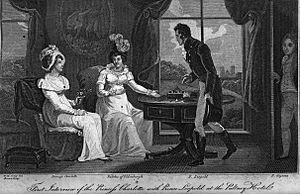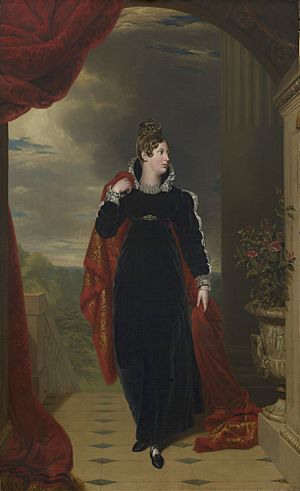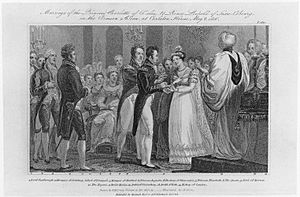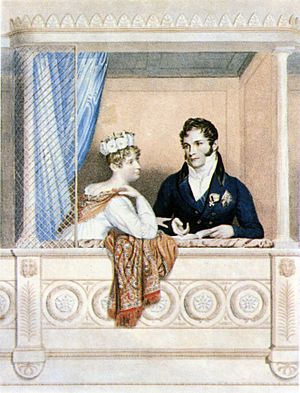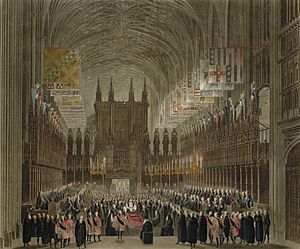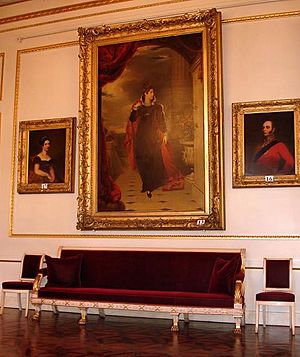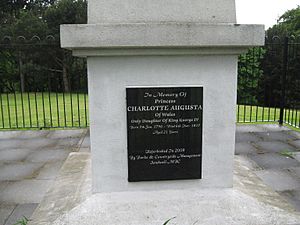Princess Charlotte of Wales (1796–1817) facts for kids
Quick facts for kids Princess Charlotte of Wales |
|||||
|---|---|---|---|---|---|
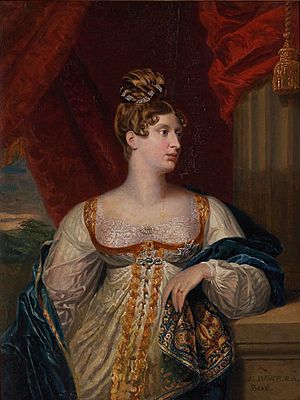
Portrait by George Dawe, 1817
|
|||||
| Born | 7 January 1796 Carlton House, London, England |
||||
| Died | 6 November 1817 (aged 21) Claremont House, Surrey, England |
||||
| Burial | 19 November 1817 Royal Vault, St George's Chapel, Windsor Castle, England |
||||
| Spouse | |||||
|
|||||
| House | Hanover | ||||
| Father | George, Prince of Wales (later George IV) | ||||
| Mother | Caroline of Brunswick | ||||
| Signature | |||||
Princess Charlotte Augusta of Wales (born 7 January 1796 – died 6 November 1817) was the only child of George, Prince of Wales, who later became King George IV. Her mother was Caroline of Brunswick. Many people expected Charlotte to become the Queen of Britain after her grandfather, George III, and her father passed away. However, she sadly died at the age of 21 while giving birth, before either of them.
Charlotte's parents did not like each other even before their arranged marriage and soon separated. Her father, the Prince of Wales, mostly left Charlotte to be raised by governesses and servants. He allowed her very little time with her mother, Caroline, who eventually left the country. As Charlotte grew up, her father tried to make her marry William, the Prince of Orange. Charlotte first agreed but then changed her mind. This led to a long disagreement between her and her father. Finally, he allowed her to marry Leopold of Saxe-Coburg-Saalfeld, who later became the King of the Belgians. After about a year and a half of a happy marriage, Charlotte died after delivering a baby boy who was stillborn.
Charlotte's death caused huge sadness across Britain. People had seen her as a sign of hope and a refreshing change from her unpopular father and her grandfather, who was mentally ill. She was King George III's only grandchild born in a royal marriage. Her death led to a problem with who would become the next ruler, as there was a chance the throne might go to a distant relative. The King's older, unmarried sons then looked for wives. It was his fourth son, Prince Edward, Duke of Kent and Strathearn, who became the father of the future queen, Queen Victoria.
Contents
Charlotte's Birth and Early Life
In 1794, George, Prince of Wales, needed to find a wife. He wasn't looking for love but was promised more money if he married. He chose his German cousin, Caroline of Brunswick, even though they had never met. When they finally met, they didn't like each other, but the wedding still happened on 8 April 1795. The couple separated just weeks later, though they still lived in the same house.
On 7 January 1796, almost nine months after the wedding, Caroline gave birth to a daughter at their home, Carlton House, in London. George was a little disappointed it wasn't a boy. But King George III, who liked baby girls, was thrilled to have his first grandchild born in a royal marriage. He hoped the baby would help George and Caroline get along, but it didn't happen. Three days after Charlotte was born, George wrote a will saying his wife would have no part in raising their child. He left all his money to his girlfriend, Maria Fitzherbert, and only one shilling to Caroline. Even though many royals were not popular, the country celebrated the princess's birth.
On 11 February 1796, she was christened Charlotte Augusta. She was named after her grandmothers, Queen Charlotte and Augusta, Duchess of Brunswick-Lüneburg. The ceremony took place in the Great Drawing Room at Carlton House. Her godparents were the King, the Queen, and Augusta.
Caroline wanted to be treated better now that she had given birth to the second-in-line to the throne. But George limited her time with Charlotte. He said she could only see their daughter if a nurse or governess was present. Caroline was allowed the usual daily visit that upper-class parents made to their young children back then. She wasn't allowed to make any decisions about Charlotte's care. However, some kind staff members didn't listen to the Prince and let Caroline be alone with her daughter. George didn't know about this, as he didn't spend much time with Charlotte himself. Caroline was even brave enough to ride through London in a carriage with her daughter, and crowds cheered them on.
Charlotte's Childhood
Charlotte was a healthy child. One writer, Thea Holme, said that early stories about Charlotte show her as "happy, reckless, and warm-hearted." As Charlotte grew, her parents kept fighting and used her in their arguments. Both parents asked the King and Queen to take their side. In August 1797, Caroline left Carlton House and moved to a rented home near Blackheath. She left her daughter behind because, at that time, English law said the father had more rights to young children. However, the Prince didn't try to stop Caroline from seeing her daughter.
In December 1798, the Prince invited his wife to spend the winter at Carlton House, but she said no. This was the last real attempt for them to get back together. Because it failed, it was unlikely George would have another son who would take Charlotte's place in line for the throne. Caroline visited her daughter at Carlton House, and sometimes Charlotte was driven to Blackheath to visit her mother. But Charlotte was never allowed to stay overnight at her mother's house. During the summers, the Prince rented Shrewsbury Lodge at Blackheath for Charlotte, which made visits easier. According to Alison Plowden, who wrote about George's family, Caroline probably saw her daughter as much as she wanted to.
When Charlotte was eight, her father decided he wanted Carlton House to himself. He moved Charlotte into Warwick House, next to Carlton House. A writer named James Chambers said that the young Princess "lived in a household of her own, in the company of no one who was not paid to be there." Charlotte's governess, Lady Elgin, who she was very close to, was not there for the move. Lady Elgin had to retire, supposedly because of her age. But it was more likely because George was angry that Lady Elgin had taken Charlotte to see the King without his permission. George also fired the sub-governess, Miss Hayman, for being too friendly with Caroline. Princess Caroline quickly hired Miss Hayman.
Lady Elgin's replacement, Lady de Clifford, liked Charlotte. But she was too kind to discipline the child, who had become a lively tomboy. Lady de Clifford brought one of her grandsons, George Keppel, who was three years younger than Charlotte, to play with her. Forty years later, Keppel, by then an Earl, wrote about Charlotte in his memories. These memories are the source of many stories about Charlotte as a little girl. Besides tomboy tales of horses and fights, he remembered them seeing a crowd outside the Keppel house. The crowd hoped to see the young Princess. The two children went outside and joined the crowd, without anyone recognizing them.
In 1805, the King started planning Charlotte's education. He hired many teachers for his only grandchild born in a royal marriage. The Bishop of Exeter was to teach her about the Church of England, which the King believed Charlotte, as queen, would one day defend. The King hoped these teachers would "make her an honor and comfort to her family, and a blessing to the countries she may later rule." However, this teaching didn't make much of an impression on Charlotte. She only chose to learn what she wanted to learn. Taught by composer Jane Mary Guest, Charlotte became a skilled pianist.
Princess Caroline's unusual behavior led to accusations in 1807 that she had been with other men since separating from George. Caroline was caring for a young child, William Austin, who some claimed was her child by another man. The Prince of Wales hoped this investigation, called "the Delicate Investigation", would let him get a divorce. He told Charlotte she couldn't see her mother. Charlotte knew about the investigation. The ten-year-old was very sad when she and her mother saw each other in the park, and Caroline, following the Prince's order, pretended not to see her. To George's disappointment, the committee found no proof that Caroline had another child. However, they did say that the Princess's behavior could easily be misunderstood. The King, who liked Caroline, had refused to see her during the investigation but started seeing her again afterward. After the investigation, the Prince reluctantly allowed Charlotte to see her mother again, but only if William Austin was not there to play with her.
Growing Up and Royal Duties
As Charlotte became a teenager, people at Court thought her behavior was not proper for a princess. Lady de Clifford complained that Charlotte let her ankle-length underdrawers show. Lady Charlotte Bury, a lady-in-waiting to Caroline, described the Princess as a "fine piece of flesh and blood" who was honest and rarely tried to act dignified. Her father was proud of how well she rode horses. She loved music by Mozart and Haydn. She also felt a connection to the character of Marianne in the book Sense and Sensibility. In 1808, Charlotte Jones became Charlotte's official miniature portrait painter.
In late 1810, King George III began his final decline into mental illness. Charlotte and the King were very fond of each other, and the young Princess was deeply saddened by his sickness. On 6 February 1811, Charlotte's father was sworn in as Prince Regent. This meant he would rule in place of the King. Charlotte rode back and forth in the gardens outside Carlton House, trying to see the ceremony through the windows. She was a big supporter of the Whig political party, just like her father had been. However, now that he had the power of the King, he did not bring the Whigs into power as many expected. Charlotte was very upset by what she saw as her father's betrayal. At the opera, she showed her support by blowing kisses to the Whig leader, Earl Grey.
George had been raised under strict rules, which he had rebelled against. Despite this, he tried to put his daughter, who looked like a grown woman at age 15, under even stricter rules. He gave her a clothing allowance that was not enough for an adult princess. He insisted that if she went to the opera, she had to sit at the back of the box and leave before the show ended. With the Prince Regent busy with government matters, Charlotte had to spend most of her time at Windsor with her unmarried aunts. She got bored and soon became very interested in her cousin George FitzClarence, who was the unofficial son of Prince William, Duke of Clarence. FitzClarence soon left to join his army group. Then, Charlotte became interested in Lieutenant Charles Hesse of the Light Dragoons. People said he was the unofficial son of Charlotte's uncle, Prince Frederick, Duke of York and Albany.
Hesse and Charlotte had several secret meetings. Lady de Clifford worried about the Prince Regent's anger if they were found out. But Princess Caroline was delighted by her daughter's feelings. She did everything she could to encourage the relationship. She even let them be alone in a room in her apartments. These meetings stopped when Hesse left to join the British army in Spain. Most of the Royal Family, except the Prince Regent, knew about these meetings. But they didn't stop them, because they didn't like how George was treating his daughter.
In 1813, as Britain was winning the Napoleonic Wars, George began to seriously think about Charlotte's marriage. The Prince Regent and his advisors chose William, the Prince of Orange. He was the son and heir of Prince William VI of Orange. Such a marriage would make Britain more powerful in Northwest Europe. William did not make a good first impression on Charlotte when she saw him at George's birthday party on 12 August. No one in charge had spoken to Charlotte about the marriage plan, but she knew all about it from palace gossip.
Dr. Henry Halford was asked to find out how Charlotte felt about the marriage. He found her unwilling, as she felt a future British queen should not marry a foreigner. The Prince Regent thought his daughter wanted to marry Prince William Frederick, Duke of Gloucester and Edinburgh. He spoke harshly to both her and Gloucester. Charlotte wrote that he "spoke as if he had the most improper ideas of my inclinations. I see that he is completely [sic] poisoned against me, and that he will never come round." She wrote to Earl Grey for advice, and he suggested she wait for a while. The matter soon appeared in the newspapers. They wondered if Charlotte would marry "the Orange or the Cheese" (referring to Gloucester cheese), "Slender Billy" [of Orange] or "Silly Billy". The Prince Regent tried a kinder approach, but failed to convince Charlotte. She wrote that "I could not quit this country, as Queen of England still less" and that if they married, the Prince of Orange would have to "visit his frogs solo". However, on 12 December, the Prince Regent arranged a dinner party for Charlotte and the Prince of Orange. He asked Charlotte for her decision. She said she liked what she had seen so far. George took this as an acceptance and quickly told the Prince of Orange.
Discussions about the marriage contract took several months. Charlotte insisted that she would not have to leave Britain. The diplomats did not want the two thrones (Britain and the Netherlands) to be joined. So, the agreement stated that Britain would go to the couple's oldest son, while the second son would inherit the Netherlands. If there was only one son, the Netherlands would go to another part of the German royal family. On 10 June 1814, Charlotte signed the marriage contract.
Charlotte had fallen in love with a Prussian prince whose identity is not certain. At a party in London, Charlotte met a general in the Russian army, Prince Leopold of Saxe-Coburg-Saalfeld. The Princess invited Leopold to visit her. He did, staying for about 45 minutes, and then wrote a letter to the Prince Regent apologizing for any improper behavior. This letter impressed George very much, even though he didn't think the poor Leopold was a suitable husband for his daughter.
The Princess of Wales (Charlotte's mother) was against her daughter marrying the Prince of Orange. She had a lot of public support. When Charlotte went out, crowds would tell her not to leave her mother by marrying the Prince of Orange. Charlotte told the Prince of Orange that if they married, her mother would have to be welcome in their home. This was a condition that the Prince Regent would surely not accept. When the Prince of Orange would not agree, Charlotte broke off the engagement.
Her father's response was to order Charlotte to stay at Warwick House until she could be moved to Cranbourne Lodge at Windsor. There, she would not be allowed to see anyone except the Queen. When told this, Charlotte ran out into the street. A man, seeing her distress, helped the inexperienced Princess find a taxi. She took it to her mother's house. Caroline was visiting friends and rushed back home. Charlotte called for Whig politicians to advise her. Many family members also gathered, including her uncle, the Duke of York. He had a paper with him to force her return if needed. After long arguments, the Whigs advised her to go back to her father's house, which she did the next day.
Life in Isolation and Finding Love
The story of Charlotte running away and returning quickly became the main topic of conversation in London. Henry Brougham, a former politician, reported, "All are against the Prince." The newspapers that opposed the government made a big deal of the runaway Princess's story. Even after an emotional reunion with his daughter, the Prince Regent soon sent her to Cranbourne Lodge. Her attendants were told never to let her out of their sight. She managed to secretly send a note to her favorite uncle, Prince Augustus, Duke of Sussex. The Duke responded by asking the prime minister, Lord Liverpool, questions in the House of Lords. He asked if Charlotte was free to come and go, if she was allowed to go to the seaside as doctors had suggested, and if the government planned to give her her own home now that she was eighteen. Liverpool avoided the questions. The Duke was called to Carlton House and scolded by the Prince Regent, who never spoke to his brother again.
Despite being isolated, Charlotte found life at Cranbourne Lodge surprisingly pleasant. She slowly became used to her situation. At the end of July 1814, the Prince Regent visited Charlotte and told her that her mother was leaving England for a long trip to Europe. This upset Charlotte, but she felt nothing she said could change her mother's mind. She was also sad about her mother's casual goodbye, "for God knows how long, or what events may occur before we meet again." Charlotte would never see her mother again. In late August, Charlotte was allowed to go to the seaside. She had asked to go to fashionable Brighton, but the Prince Regent refused. Instead, he sent her to Weymouth.
As the Princess's carriage stopped along the way, large, friendly crowds gathered to see her. According to Thea Holme, "her affectionate welcome shows that already people thought of her as their future Queen." When she arrived in Weymouth, there were lights and a sign that said "Hail Princess Charlotte, Europe's Hope and Britain's Glory." Charlotte spent time exploring nearby places, shopping for French silks, and from late September, taking warm seawater baths. She was still interested in her Prussian prince and hoped he would tell the Prince Regent he wanted to marry her. If he didn't, she wrote to a friend, she would "take the next best thing, which was a good tempered man with good sence [sic] ... that man is the P of S-C" [Prince of Saxe-Coburg, meaning Leopold]. In mid-December, just before leaving Weymouth, she "had a very sudden and great shock" when she heard that her Prussian prince had found someone else. After Christmas dinner, father and daughter had a long talk and settled their differences.
In early 1815, Charlotte decided that Leopold (or "the Leo" as she called him) was the one she wanted to marry. Her father refused to give up hope that Charlotte would agree to marry the Prince of Orange. However, Charlotte wrote, "No arguments, no threats, shall ever bend me to marry this detested Dutchman." Facing strong opposition from the Royal Family, George finally gave in and dropped the idea of marriage to the Prince of Orange. The Prince of Orange then became engaged to Grand Duchess Anna Pavlovna of Russia that summer. Charlotte contacted Leopold through others and found him interested. But with Napoleon starting the conflict again in Europe, Leopold was away fighting with his army. In July, just before returning to Weymouth, Charlotte formally asked her father for permission to marry Leopold. The Prince Regent replied that with the uncertain political situation in Europe, he could not consider such a request. To Charlotte's frustration, Leopold did not come to Britain after peace was restored, even though he was in Paris, which she thought was a short trip from Weymouth or London.
In January 1816, the Prince Regent invited his daughter to the Royal Pavilion in Brighton. She begged him to allow the marriage. When she returned to Windsor, she wrote to her father, "I no longer hesitate in declaring my partiality in favour of the Prince of Coburg—assuring you that no one will be more steady or consistent in this their present & last engagement than myself." George gave in and called for Leopold, who was in Berlin on his way to Russia, to come to Britain. Leopold arrived in Britain in late February 1816 and went to Brighton to meet the Prince Regent. After Charlotte was also invited and had dinner with Leopold and her father, she wrote:
I find him charming, and go to bed happier than I have ever done yet in my life ... I am certainly a very fortunate creature, & have to bless God. A Princess never, I believe, set out in life (or married) with such prospects of happiness, real domestic ones like other people.
The Prince Regent was impressed by Leopold. He told his daughter that Leopold "had every qualification to make a woman happy." Charlotte was sent back to Cranbourne on 2 March, leaving Leopold with the Prince Regent. On 14 March, an announcement was made in the British House of Commons to great approval. Everyone was relieved that the drama of the Princess's love life was over. Parliament passed a law making Leopold a British citizen. They gave him £50,000 per year and bought Claremont House for the couple. They also gave them a large one-time payment to set up their home. George also thought about making Leopold a royal duke, the Duke of Kendal. But this plan was dropped because the government worried it would involve Leopold in politics. Also, some thought becoming a 'mere duchess' would be seen as a step down for Charlotte. Fearing another problem like the Orange engagement, George limited Charlotte's contact with Leopold. When Charlotte returned to Brighton, he only let them meet at dinner and never allowed them to be alone.
The wedding ceremony was set for 2 May 1816. On the wedding day, huge crowds filled London. The wedding guests had great difficulty traveling. At nine o'clock in the evening, in the Crimson Drawing Room at Carlton House, the couple were married. Leopold dressed for the first time as a British General, and the Prince Regent wore a Field Marshal's uniform. Charlotte's wedding dress cost over £10,000. The only small problem was during the ceremony when Charlotte giggled. This happened when the not-so-rich Leopold promised to give her all his worldly goods.
Marriage and Sad Passing
The couple spent their honeymoon at Oatlands Palace, the Duke of York's home in Surrey. Neither of them felt very well, and the house was full of the Yorks' dogs and the smell of animals. Still, the Princess wrote that Leopold was "the perfection of a lover." Two days after the wedding, the Prince Regent visited them. He spent two hours describing military uniforms to Leopold. Charlotte wrote that this was "a great mark of the most perfect good humour." Princess Charlotte and her husband returned to London for the social season. When they went to the theatre, the audience always cheered loudly and sang "God Save the King." When Charlotte became ill at the Opera, there was great public worry about her. It was announced that she had suffered a miscarriage. On 24 August 1816, they moved into their new home at Claremont.
Leopold's doctor, Christian Stockmar, wrote that in the first six months of their marriage, he never saw Charlotte wear anything that wasn't simple and tasteful. He also noted that she was much calmer and more in control of herself than before. He believed this was because of Leopold's influence. Leopold later wrote, "Except when I went out to shoot, we were together always, and we could be together, we did not tire." When Charlotte got too excited, Leopold would simply say, "Doucement, chérie" ("Gently, my love"). Charlotte accepted the correction and started calling her husband "Doucement."
The Coburgs, as they were called, spent the Christmas holidays at the Brighton Pavilion with other royals. On 7 January, the Prince Regent held a huge ball there to celebrate Charlotte's 21st birthday. But the Coburgs did not go. They had returned to Claremont and preferred to stay there quietly. At the end of April 1817, Leopold told the Prince Regent that Charlotte was pregnant again. It looked like she would carry the baby to full term.
Charlotte's pregnancy was of huge public interest. Betting shops quickly started taking bets on whether the child would be a boy or a girl. Economists even calculated that the birth of a princess would raise the stock market by 2.5%, and a prince would raise it by 6%. Charlotte spent her time quietly, often sitting for a portrait by Sir Thomas Lawrence. She ate a lot and didn't get much exercise. When her medical team started prenatal care in August 1817, they put her on a strict diet. They hoped this would reduce the baby's size at birth. The diet, and sometimes bleeding, seemed to make Charlotte weaker. Stockmar was surprised by this treatment, which he thought was old-fashioned. He refused to join the medical team, believing that, as a foreigner, he would be blamed if anything went wrong.
Much of Charlotte's daily care was handled by Sir Richard Croft. Croft was not a doctor but a midwife, very popular among wealthy people. Charlotte was expected to give birth on 19 October. But as October ended, she showed no signs of labor. She drove out as usual with Leopold on Sunday, 2 November. On the evening of 3 November, her contractions began. Sir Richard encouraged her to exercise but would not let her eat. Late that evening, he sent for the officials who were to witness and confirm the royal birth. As 4 November turned into 5 November, it became clear that Charlotte might not be able to deliver the child. Croft and Charlotte's personal doctor, Matthew Baillie, decided to send for obstetrician John Sims. However, Croft did not allow Sims to see the patient, and medical tools called forceps were not used. According to Alison Plowden, these tools might have saved her and the child. However, there was a very high death rate when instruments were used before antiseptics were common.
At nine o'clock in the evening of 5 November, Charlotte finally gave birth to a large stillborn boy. Efforts to revive him failed. The royal observers confirmed it was a handsome boy, looking like the Royal Family. They were told the mother was doing well and then left. An exhausted Charlotte heard the news calmly, saying it was God's will. She ate some food after her long fast and seemed to be getting better.
Soon after midnight, Charlotte started vomiting violently and complained of pains in her stomach. Sir Richard was called and was alarmed to find his patient cold to the touch, breathing with difficulty, and bleeding. He placed hot compresses on her, which was the accepted treatment at the time for bleeding after childbirth. But the bleeding did not stop. He called Stockmar and urged him to bring Leopold. Stockmar found Leopold hard to wake up. He went to see the Princess, who grabbed his hand and told him, "They have made me tipsy." Stockmar left the room, but Charlotte's voice called him back, "Stocky! Stocky!" He entered the room to find her dead.
The Impact of Her Death
Henry Brougham wrote about the public's reaction to Charlotte's death, "It really was as though every household throughout Great Britain had lost a favourite child." The whole country went into deep mourning. Shops that sold black fabric ran out. Even the poor and homeless tied black armbands on their clothes. Shops closed for two weeks, as did the Royal Exchange, the Law Courts, and the docks. Even gambling places shut down on the day of her funeral, as a sign of respect. The Times newspaper wrote, "It certainly does not belong to us to complain about God's actions... there is nothing wrong in grieving for that as a disaster." The mourning was so complete that makers of ribbons and other fancy goods (which could not be worn during mourning) asked the government to shorten the period. They feared they would go out of business otherwise.
The Prince Regent was overwhelmed with sadness and could not attend his child's funeral. Princess Caroline heard the news from a messenger and fainted in shock. When she recovered, she said, "England, that great country, has lost everything in losing my ever beloved daughter." Even the Prince of Orange cried when he heard the news, and his wife ordered the ladies of her court to wear mourning clothes. The greatest impact was on Prince Leopold. Stockmar wrote years later, "November saw the ruin of this happy home, and the destruction at one blow of every hope and happiness of Prince Leopold. He has never recovered the feeling of happiness which had blessed his short married life." According to Thea Holme, "without Charlotte he was incomplete. It was as if he had lost his heart." Leopold remained a widower until he remarried in 1832 to Louise of Orleans after he became King of the Belgians. His youngest daughter, later known as Empress Carlota of Mexico, was named in honor of his lost wife.
Prince Leopold wrote to Sir Thomas Lawrence:
Two generations gone. Gone in a moment! I have felt for myself, but I have also felt for the Prince Regent. My Charlotte is gone from the country—it has lost her. She was a good, she was an admirable woman. None could know my Charlotte as I did know her! It was my study, my duty, to know her character, but it was my delight!
The Princess was buried, with her son at her feet, in St. George's Chapel, Windsor Castle, on 19 November 1817. A monument by the sculptor Matthew Cotes Wyatt was built at her tomb, paid for by public donations. It wasn't long before people started to blame others for the tragedy. The Queen and the Prince Regent were blamed for not being present at the birth, though Charlotte had specifically asked them to stay away. Although the examination after death was not clear, many blamed Croft for his care of the Princess. The Prince Regent refused to blame Croft.
An obelisk (a tall, four-sided pillar) in memory of Charlotte was built by Robert Wellbeloved Scott, who was a Member of Parliament for Walsall. It was placed in the grounds of his country house (now Red House Park, in Sandwell). The obelisk became very damaged over time. In August 2009, it was restored at a cost of £15,000.
Charlotte's death meant the King had no grandchildren born in a royal marriage. His youngest living child was over forty. Newspapers urged the King's unmarried sons to get married. One such article reached the King's fourth son, Prince Edward, Duke of Kent and Strathearn, at his home in Brussels. He quickly ended his relationship with his girlfriend, Julie de St Laurent, and proposed to Leopold's sister Victoria, Dowager Princess of Leiningen. Their daughter, Victoria, became Queen of the United Kingdom in 1837.
Images for kids
See also
 In Spanish: Carlota Augusta de Gales para niños
In Spanish: Carlota Augusta de Gales para niños



